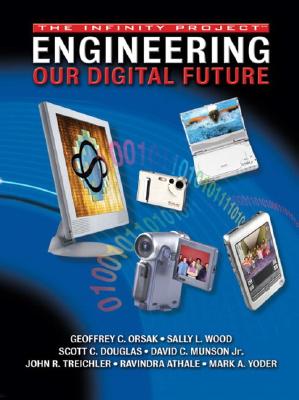You are here
Back to topEngineering Our Digital Future: The Infinity Project (Hardcover)
Description
This book, Engineering Our Digital Future, plus a broad spectrum of supplemental materials, classroom technology, and a comprehensive instructor training program--work in concert to motivate users to learn about the infinite possibilities of technology and engineering in today's world. Developed by a national team led by Southern Methodist University and Texas Instruments, this book is the first of its kind in the country. KEY TOPICS: Chapter topics include: The World of Modern Engineering; Creating Digital Music; Making Digital Images; Math You Can See; Digitizing the World; Coding Information for Storage and Secrecy; Communicating with Ones and Zeros; Networks from the Telegraph to the Internet; and The Big Picture. MARKET: A new outlook into the possibilities of technology and engineering for beginner engineers.
About the Author
Geoffrey C. Orsak is Associate Dean for Research and Development and a Professor with the Department of Electrical Engineering, Southern Methodist University. He also serves as the Executive Director of the federally supported Institute for Engineering Education at SMU and Director of the Infinity Project. Dr. Orsak is widely regarded as one of the nation's leaders in K-12 engineering education. In addition to these activities, he has served as an advisor on matters associated with the science and technology of national defense to the U.S. Department of Defense; the National Academy of Engineering; the Institute for Defense Analysis, among others. Dr. Orsak received the B.S.E.E., M.E.E., and Ph.D. degrees in electrical and computer engineering from Rice University, Houston, TX. Sally L. Wood is a Professor with the Department of Electrical Engineering, Santa Clara University, the oldest university in California. For the past six years, she has also been the head of the department. She was born in Swansea MA, raised in Georgia, and graduated from high school in Washington state. After she received the B.S. degree from Columbia University, she worked for five years in the northeast and in Europe designing systems to automatically read printed text. She then returned to graduate school at Stanford University and earned a Ph.D. degree for research on medical imaging. She enjoys teaching classes from the freshman level to the graduate level in digital logic and signal processing and continues her research on video and image processing. She is a past vice president of the IEEE Signal Processing Society. Scott C. Douglas is an Associate Professor with the Department of Electrical Engineering, Southern Methodist University. He is also the Associate Director for the Institute for Engineering Education at SMU. Before attending college, he was drawn to engineering through his love of music and the arts, and he has performed in numerous orchestras, bands, and musical groups as a saxophonist and singer throughout his life. He received the B.S., M.S., and Ph.D. degrees from Stanford University. Afterward, he became a professor, educator, and engineering researcher. He regularly consults with companies all over the world on topics related to his research interests, which focus on the processing of acoustic signals for sound and vibration control, speech enhancement, and spatial understanding. David C. Munson, Jr. is both the Chairman and a Professor with the Department of Electrical and Computer Engineering, University of Michigan. Prior to this, he was a Professor with the Department of Electrical and Computer Engineering, University of Illinois, Urbana-Champaign. His research focuses on computer algorithms for tomography and synthetic aperture radar. In addition to his research, Dr. Munson particularly enjoys being in the classroom, where he has taught thousands of students their first course in digital signal processing. He received the B.S. degree from the University of Delaware and the M.S., M.A., and Ph.D. degrees from Princeton University, all in electrical engineering. Dr. Munson is a past-president of the IEEE Signal Processing Society and the founding editor-in-chief of the IEEE Transactions on Image Processing. John R. Treichler is the Chief Technical Officer of Applied Signal Technology, Inc., an engineering company that builds specialized electronic equipment for the U.S. government and its friends overseas. His research focuses on the application of advanced technology to communications systems. Dr. Treichler has been a professor at both Cornell University and Stanford University. He received the B.A. and Masters of Electrical Engineering degrees from Rice University and the Ph.D. degree from Stanford University. He served aboard ships as an officer in the U.S. Navy, and continues to work at the company he co-founded. Ravindra Athale is currently a Program Manager of Photonics at the Defense Advanced Research Projects Agency (DARPA), on leave from George Mason University. Prior to this, he has worked at various government research labs and in private industry. He has been fascinated by everything optical--lasers, holography, liquid crystals, optical computers--for his entire career. He is the co-inventor of HoloSpex glasses, which is the first mass scale consumer product based on the esoteric technology of far-field computer-generated holography. Dr. Athale received the B.Sc. and M.Sc. degrees in physics in India and the Ph.D. degree from the University of California, San Diego, in electrical engineering. During his career as a professor, he has developed and taught a course that teaches principles of information technology to non-science and engineering students. Mark A. Yoder is a Professor with the Department of Electrical and Computer Engineering, Rose-Hulman Institute of Technology, Terre Haute, IN. Dr. Yoder received the B.S. degree in 1980 and the Ph.D. degree in 1984, both in electrical engineering and both from Purdue University. While working as a research scientist, he discovered that teaching engineering was most enjoyable, prompting him to join Rose-Hulman Institute of Technology. He is a national leader in teaching digital signal processing to young college students, using symbolic algebra systems in electrical engineering education and in developing engineering curriculums for high school students.

